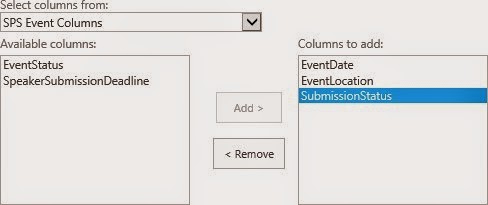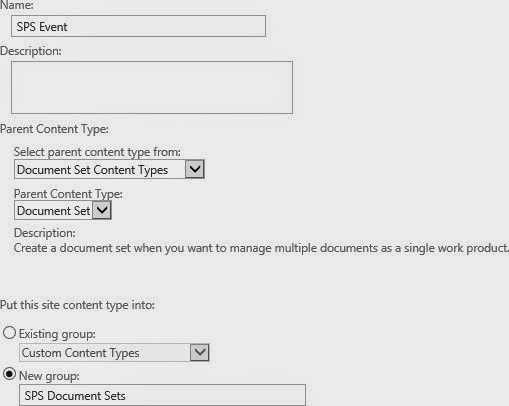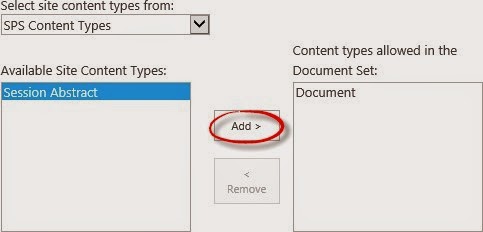While
document sets are a somewhat simple concept, there is a certain order that you
must follow to build a document set efficiently. Below is the order followed by
a detailed explanation of each step.
- Create site columns and content types.
- Assign site columns.
- Publish content types.
- Run Content Type Subscriber timer job.
- Create document set content types.
- Define document set settings and assign additional site columns.
- Publish document set content types.
- Run Content Type Subscriber timer job.
- Assign Document Set Content Type to document library.
- Create a
document set.
Before you create the document set, you will need to make sure your desired content types and site columns already exist. Both are created from Site Settings, either at the content type hub or site level. I prefer to create them within my content type hub so that they can be used throughout my SharePoint environment, not just in one site collection.
Step 2 – Assign Site Columns
If you create a new content type, click Add from existing site columns to assign site columns to capture specific metadata. You can use existing site columns, also created within your content type hub, or you can create site columns at the site level. Alternatively, you can add site columns to the document set in which the content type will be allowed. The benefit of adding the site columns to the document set or content type is only having to add them once.
If you create a new content type, click Add from existing site columns to assign site columns to capture specific metadata. You can use existing site columns, also created within your content type hub, or you can create site columns at the site level. Alternatively, you can add site columns to the document set in which the content type will be allowed. The benefit of adding the site columns to the document set or content type is only having to add them once.
Step 3 – Publish Content Types
When you have your content type just the way you want it, don’t forget to publish it. Click Manage publishing for this content type, select the radio button for Publish (or Republish if you are updating the content type with changes), and click OK.
When you have your content type just the way you want it, don’t forget to publish it. Click Manage publishing for this content type, select the radio button for Publish (or Republish if you are updating the content type with changes), and click OK.
Step 4 – Run Content Type Subscriber Timer Job
Published (or republished) content types created in the content type hub will become available for use once the Content Type Subscriber timer job runs. If you have SharePoint on-premises and access to Central Administration, you can manually run this timer job. Go to Monitoring > Review Job Definitions and click Content Type Subscriber. You will see its schedule and the last time it ran. Rather than waiting for the next scheduled run, click Run Now to start the timer job.
Published (or republished) content types created in the content type hub will become available for use once the Content Type Subscriber timer job runs. If you have SharePoint on-premises and access to Central Administration, you can manually run this timer job. Go to Monitoring > Review Job Definitions and click Content Type Subscriber. You will see its schedule and the last time it ran. Rather than waiting for the next scheduled run, click Run Now to start the timer job.
Note: If you have SharePoint Online or Office 365, you do not have access to the timer job in Central Administration. Instead, go to Site Settings > Content Type Publishing within your content type hub, mark the checkbox for Refresh all published content types on next update, and click OK.
Step 5 – Create Document Set Content Types
Document sets are created in Site Settings > Site Content Types. If you create the document set within your content type hub, it can be used throughout all of your site collections. The only real decisions when creating the document set are what to name it and where to put it because the Parent Content Type will logically be Document Set.
Document sets are created in Site Settings > Site Content Types. If you create the document set within your content type hub, it can be used throughout all of your site collections. The only real decisions when creating the document set are what to name it and where to put it because the Parent Content Type will logically be Document Set.
Step
6 – Define Document Set Settings and Assign Additional Site Columns
Now you can define your document set. Start by clicking Document Set settings. First, choose which content types are allowed in the document set. Filter the available site content types by selecting the group into which you put the new content types. Then highlight the desired content type and click Add. If necessary, you can change the group and add additional content types without saving between groups.
Now you can define your document set. Start by clicking Document Set settings. First, choose which content types are allowed in the document set. Filter the available site content types by selecting the group into which you put the new content types. Then highlight the desired content type and click Add. If necessary, you can change the group and add additional content types without saving between groups.
If you do not want the default content
type, you must delete it from the Default Content before you can remove it from
the content types allowed in the document set.
For me, the most attractive attribute
of the document set was the ability for items in the document set to inherit
the metadata assigned at the document set level. This is achieved through
shared columns. In the Document Set settings, mark the checkbox for each column
that documents should inherit.
Document sets also have a welcome
page that can display its shared columns. Highlight the column to be shared and
click Add.
If you make changes to the site
columns, such as adding more or rearranging the order, you may want to update
the welcome page for document sets inheriting from your document set content
type. Just mark the checkbox in the Document Set settings.
Another way
to customize the document set is to add additional site columns. Click Add
from existing site columns and follow the same process as outlined above in
Step 2.
Step 7 – Publish Document Set Content Types
When your
document set is ready, make sure you publish it. This is the same process that you
did in Step 3 to publish the newly created content types.
Step 8 – Run Content Type Subscriber Timer Job
Just like
step 4, you must run the Content Type Subscriber timer job from Central
Administration, assuming you created your document sets within the content type
hub. Alternatively, you can wait for the timer job to run on its normal
schedule.
Note: For SharePoint Online or Office 365, you can return to Content Type Publishing, as mentioned in step 4.
Step 9 - Assign Document Set Content Type to Document
Library
Now that your document set is available for use, you must assign it to the document library. First, go to Library Settings and click Advanced Settings. Select the Yes radio button for Allow management of content types. Click OK to save the changes.
Upon returning to the Document Library settings, scroll down to the Content Types section. First, click Add from existing site content types. Highlight the desired document set and click Add. Repeat until all of the desired document sets are listed under Content types to add and click OK.
Next, click Change new button order and default content type. If there are any content types that you do not want displayed on the new document menu, unmark the checkbox for those content types under Visible. Arrange the content types in the order in which they should appear on the new document menu by assigning the appropriate numerical value under Position from Top. The content type in the first position will become the default content type.
More Advantages of Document Sets
Now that your document set is available for use, you must assign it to the document library. First, go to Library Settings and click Advanced Settings. Select the Yes radio button for Allow management of content types. Click OK to save the changes.
Upon returning to the Document Library settings, scroll down to the Content Types section. First, click Add from existing site content types. Highlight the desired document set and click Add. Repeat until all of the desired document sets are listed under Content types to add and click OK.
Next, click Change new button order and default content type. If there are any content types that you do not want displayed on the new document menu, unmark the checkbox for those content types under Visible. Arrange the content types in the order in which they should appear on the new document menu by assigning the appropriate numerical value under Position from Top. The content type in the first position will become the default content type.
Step 10 - Create a Document Set
Navigate to the document library where the document set content type was enabled. From the ribbon, click Files and select the document set from the New Document menu.
Navigate to the document library where the document set content type was enabled. From the ribbon, click Files and select the document set from the New Document menu.
Disadvantages of Document Sets
What don’t I like about document sets? First and foremost, you cannot create a view within a document set, thus preventing you from sorting, filtering, or grouping. Also, unless you disable the option to Make “New Folder” command available in the library’s Advanced Settings, you can create folders and subfolders within the document set. While I do not fully support the use of folders, another disadvantage of document sets (and document libraries) is that you cannot drag folders into the document set. (The workaround is to open the document library or document set using the Open with Explorer feature.)
What don’t I like about document sets? First and foremost, you cannot create a view within a document set, thus preventing you from sorting, filtering, or grouping. Also, unless you disable the option to Make “New Folder” command available in the library’s Advanced Settings, you can create folders and subfolders within the document set. While I do not fully support the use of folders, another disadvantage of document sets (and document libraries) is that you cannot drag folders into the document set. (The workaround is to open the document library or document set using the Open with Explorer feature.)
Let’s end on a positive note. First,
you can drag and drop up to 100 files into a document set. (If you don’t see
drag files here, check your version of Internet Explorer and/or my blog post on
Using
Office 2010 with SharePoint 2013.) Because
document sets are part of a document library, you can create views within the
library. Those views do allow you to sort, filter, and group; and you can
create a view that shows all the documents without folders. However, the
document set will display as an item. You can also export the view to Excel,
where you can do additional sorting and filtering.
Wrap Up
Document sets are a great way to promote metadata and replace folders without taking away any security features. By referring to document sets as special folders, users can maintain the comfort they have developed with folders while getting away from infinite levels of subfolders.
Wrap Up
Document sets are a great way to promote metadata and replace folders without taking away any security features. By referring to document sets as special folders, users can maintain the comfort they have developed with folders while getting away from infinite levels of subfolders.
Additional Resources














Hi Ben, thanks for the info. The Welcome Page View associated with a document set was available in SharePoint 2010 but no longer exists in SharePoint 2013. In SP2013, you can change the default view of the library and the document set will use that default view; but you cannot have separate views per document set content type like you could in SP2010.
ReplyDeleteHello, I am relatively new to SharePoint, I would like to know if there is a way to use an InfoPath form when creating the Document Set? E.g. In your last illustration the user clicks on "Create a new SPS Event" and instead of filling out a default menu form they use an InfoPath form which has more options for input rules etc
ReplyDeletePlease help. I can set the column order for some of the columns in my custom Content Type (document set) but some of the columns will not display in the order that I specify when creating a new item. Is there a trick to this?
ReplyDeleteIs there a way to update existing Document Sets in Bulk?
ReplyDeleteYou mean update Document Sets metadata in bulk? This can be done in the Quick Edit view (Datasheet view in 2010).
DeleteWhile you can't create views for Document Sets, you CAN create a view at the library level (ie. go either up a level, or go to site settings). Then in the Document Set properties page, you can set it as the default view for the Document Set. I usually do this when I don't want to show all the inherited values for each file inside a Document Set, so I create an "Inside Doc Set" type view.
ReplyDeleteIs there a way to make sure that a user can only put (new) documents in a document set (and not in the 'root' of the library)?
ReplyDeleteYes, there is - well sort of. You can hide all the Document Content Types from the New menu from the Library Settings page and just leave your Doc Set CT available. Then in the Doc Set specify which CTs can be available from within the Doc Set.
DeleteNote, this stops users creating new documents in the root folder but I guess they can still upload them there
Thank you for sharing wonderful information.
ReplyDeleteSharePoint Online Training
Theresa, thanks for the great post! You wrote:
ReplyDelete"Those views do allow you to sort, filter, and group; and you can create a view that shows all the documents without folders. However, the document set will display as an item."
I am trying to create a view of the Document Library to show one Document Set with the folders inside of it. But it seems I can only show the (flattened) files inside the Document Set, but without the folders being visible. It doesn't seem possible to do show the folder structure in the Document Sets.
Am I missing something?
This is really great informative blog. Keep sharing.
ReplyDeleteSharePoint Online Training
Really, these quotes are the holistic approach towards mindfulness. In fact, all of your posts are. Proudly saying I’m getting fruitfulness out of it what you write and share.
ReplyDeleteDocument Management Software Dubai
Document Management Software
Document Management Software UAE
I am happy for sharing on this blog its awesome blog I really impressed. thanks for sharing. Great efforts.
ReplyDeleteSalesforce Training in Chennai
Salesforce Online Training in Chennai
Salesforce Training in Bangalore
Salesforce Training in Hyderabad
Salesforce training in ameerpet
Salesforce Training in Pune
Salesforce Online Training
Salesforce Training
They’re very convincing and will definitely work. Nonetheless, the posts are too short for novices. May you please extend them a bit from subsequent time? Thank you for the post.
ReplyDeleteDocument Management Software
Document Management System
Electronic Document Management Software
Cloud Document Management System
KotaBet-Nh: Online Casino, Poker, Baccarat, Roulette
ReplyDeleteKotaBet is kadangpintar a free online casino offering a wide หาเงินออนไลน์ range of games for players of all levels of skill level. It 샌즈카지노 has some of the greatest slots, roulette, blackjack, baccarat,